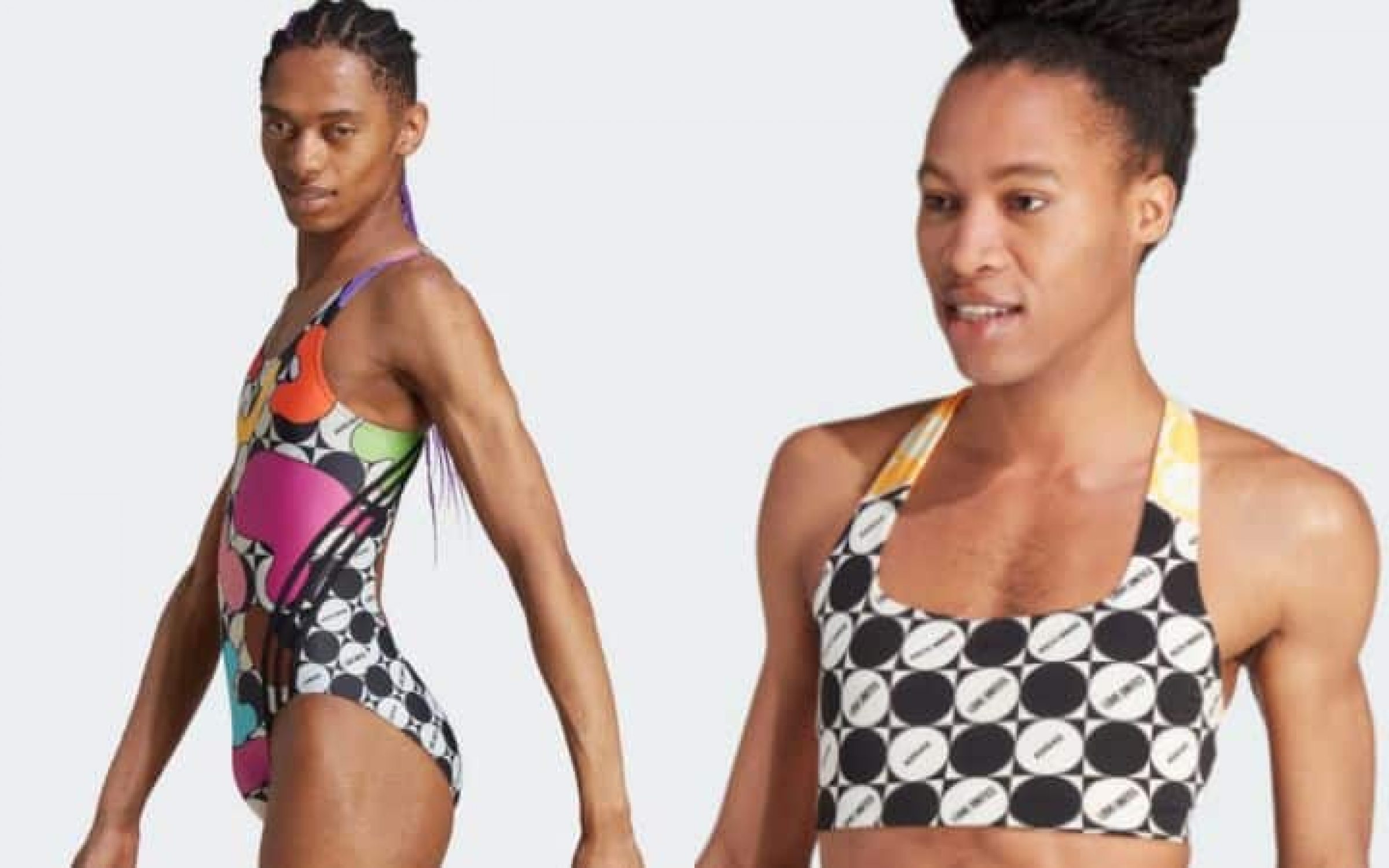Oh dear. Here we go again. Yet another giant corporation is committing hari-kari and alienating at least half of its customers in an effort to be cool.
Step forward Adidas, the vast German sportswear group, which is causing a storm because a male model has been used to show off one of its new collections of womens swimwear.
And as you might expect of a 6ft 2″ male model, he has a hairy chest sprouting out from the swimsuit – which sells for $70 – and there is a bulge in the crotch area.
No problem with that, you might say. Men – or indeed trans women – are welcome to wear swimsuits or anything they want. Indeed, it’s not so very long ago that the male species did wear swimsuits – or rather bathing costumes. Look back to photographs of the 1920s and 1930s when men first began to go without shirts for swimming. Speedos and trunks were still new and for the very brave – invented in 1914 by an Australian – and didn’t take off until many years later. So it soon became the norm for men to wear those singlet style bathing suits.
Here’s the problem with the Adidas advert for me: it’s being marketed and sold under the women’s section. Yet the swimsuits in question have no visible darts or cups suitable for the female form so it doesn’t look as though it was designed for most women.
The question to be asked of Adidas is why doesn’t it sell this latest swimwear in the male collection? If men – or trans women – want to wear female swimsuits with their wobbly bits, then surely the adverts should be marketed under menswear? Why take over the women section?
No wonder that leading US swimmers and other commentators are calling for a boycott of Adidas, claiming that the sportswear giant is “erasing women.” A ‘BoycottAdidas’ hashtag is already trending and a number of high-profile athletes such as US swimming star and women’s rights activist Riley Gaines are quite rightly outraged. Gaines tweeted: “Women’s swimsuits aren’t accessorized with a bulge. “I don’t understand why companies are voluntarily doing this to themselves. They could have at least said the suit is “unisex”, but they didn’t because it’s about erasing women.”
I wouldn’t go that far but there is something disturbingly weird about what Adidas is trying to achieve with this latest campaign which is triggering much mirth – as well as disgust – on Twitter. One post from Oli London, a boy band member who is well-known for plastic surgery procedures, showed pictures from the campaign with the caption: “The new Adidas Women’s Swimwear Range modelled by…men. There doesn’t seem to be a single brand left that isn’t woke.” The post has been viewed by five million Twitter users.
Others were cheekier. “Nothing sells a swimsuit like a hairy chest and a crotch bulge,” wrote another. And another: “Just check out that womanly bulge… Adidas infuriatingly uses biological male models to advertise women’s swimsuits, and bras.”
Supposedly, all the women’s products being modelled by a man – Adidas has been careful not to indicate whether he is trans or not – are part of it’s “Pride 2023” collection which, according to the ghastly marketing blurb, is “a celebration of self-expression, imagination and the unwavering belief that love unites.”
Jesus wept. What women actually want from a swimsuit is one that is beautifully crafted to hold in all the various bits and bobs which adorn us and solid support for extra flesh.
So this marketing stuff is twaddle, pure and simple.
What is particularly odd about the timing of the Adidas advert is that it follows on the heels of the outrage over the partnership between TikTok sensation, Dylan Mulvaney, the transgender influencer, and Anheuser-Busch In-Bev, over her recent outing with Bud Light.
Mulvaney – who has 11 million social media followers – triggered widespread fury over her drinking from a Bud Light can which featured her face while sitting naked in a bath.
Under the hashtag #budlightpartner, he/she joked that they didn’t even know which sport she was meant to be promoting – it was the NCAA March Madness tournament. Unsurprisingly, Mulvaney’s social media posting also sparked calls for a boycott from across the political spectrum and not just anti-wokers.
Yet according to the brewer’s CEO, Michel Doukeris, Mulvaney’s posts on Instagram were never part of an advertising campaign but “one can, one can, one influencer, one post and not a campaign.” The can was supposedly sent to her to celebrate the recent year-long journey transitioning to being a woman.
Yet this is slightly disingenuous coming from Doukeris – and his advertising people – who will have known she is a TikTok star and bound to post to her legion of social media fans.
But the partnership blew up in their faces. The media storm proved a disaster for Anheuser-Busch, wiping more than $6 billion off the brewing giant’s market capitalisation. Sales collapsed by as much as 20 per cent in one week and by the end of April, Bud Light sales had fallen 23 percent.
Anheuser-Busch reacted promptly, with two marketing executives dismissed on garden leave. Did Adidas not learn any lessons from the Bud Light episode? Apparently not. Some say the German giant is too intent on getting its own back on Nike as to which is the cooler brand – the two sportswear companies are bitter rivals – as Nike also used Mulvaney recently to promote its women’s sportswear. Yet this also provoked tantrums, with a Burn Bra Challenge launch on TikTok, and threats of boycotts.
Should we be concerned by these latest incidents in which big corporations are using their powerful reach with consumers to play politics or take on the role of moral arbiters? Should they mix morality with consumerism ? It’s an old chestnut and a debate that has been with us for years.
When the Tiger Woods affair broke more than a decade ago, it didn’t take long before some of the world’s biggest sports sponsors like Nike, Gillette and Gatorade played the moral high ground, threatening to pull his lucrative $ 100 million of sponsorship deals. Within hours, Woods publicly apologised and the brands, now happy, returned to backing the golfing celebrity.
As traditional forms of advertising decline, companies are under huge pressure to experiment with new ways to sell their products. Finding influencers like Mulvaney or causing a stir with a male model selling women’s swimsuits is just another way for corporations to reach their audience – and be provocative at the same time.
Benetton came to the public’s attention in the 1980s with some truly shocking adverts: the Pope Benedict XVI kissing imam Sheik Ahmed el-Tayeb was one step too far, and had to be removed. Other controversial ads included the photograph of AIDS victim David Kirby – first seen in Life magazine – as he lay on his deathbed dying of Aids and several other sexualised and often upsetting violent images. Luciano Benetton defended the retailer, explaining that the fashion chain did not create adverts to provoke, but “to make people talk and to develop citizen consciousness.”
Provoke or talk: it’s the same thing. And in the grand scheme of things, it’s a first-world problem. The best response to the ridiculous Adidas ad or Mulvaney drinking Bud Light in the bath is to laugh. And not buy the swimsuit or the beer. That’s the best way of telling corporations that they are looking silly.
There are of course dangers: some of the messages being sold by these giant companies may well have undue influence on the most vulnerable, making them question their identity, their gender or indeed, their purpose in life.
Which is why we have regulators to call a halt on companies, and their advertising tricks, when they overstep the mark, and they must be constantly vigilant in their policing. Ultimately though, it’s the consumer who has the power to boycott the product. And shareholders can vote with their feet and sell the offending company’s shares.
Write to us with your comments to be considered for publication at letters@reaction.life




